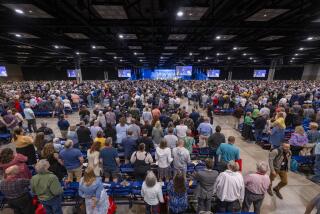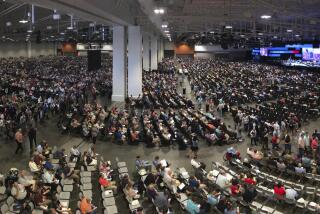Southern Baptists Learn Bigger Is Not Always Better : Research: Drive to consolidate created mid-size congregations whose members give less in time and money than members of smaller ‘house churches,’ study shows.
- Share via
Earlier this century, Southern Baptists took over the South with their ability to start new congregations in rural areas too small for other denominations to bother with.
All it took was a few people and a lay preacher and they had a church.
But in the past 40 years, the denomination took a deliberate turn to larger churches. The smaller churches were closed and merged, and big churches with seminary-trained pastors became the trend.
What they have found is that bigger is not necessarily better, according to a new study in the Review of Religious Research. Increasing the size of congregations has brought with it a flood of mid-size congregations whose members give less in time and money than members of smaller congregations.
With the Southern Baptist Convention now at the top of the hill of Protestant denominations in terms of size, there is the beginning of a movement back to the “house churches” that first gave the organization its strength.
“It’s really only been in the last generation that we’ve created these large churches and our smaller churches became mid-sized churches,” said the Rev. David Palmer, associate director of the convention’s New Church Extension Division. “We made a fatal connection. We sold the idea to be a real church you had to have a full-time preacher.”
In the Review of Religious Research, sociologist Roger Finke of Purdue University traces the subtle but dramatic transformation of the Southern Baptist Convention from a group of small, fiercely independent churches to a denomination larger than its mainline counterparts in average church size and increasingly run by professionally trained clergy.
The average size of a Southern Baptist church increased by only 30 members, from 85 to 115 during the first 75 years of the convention’s history, 1845 to 1920, Finke said. During the past 70 years, congregation size has more than tripled to nearly 400 members.
Compared to those in other Protestant churches, the changes have been particularly striking, Finke said. For example, until 1950 Southern Baptists averaged 255 members per church, less than the average of 277 members per church of Protestant denominations with more than 1 million members. By 1990, the other denominations had increased their church size to only 297, while the Southern Baptists increased to 396 members per church.
To run these larger churches, congregations became less dependent on local preachers who would have another job in town to support themselves, and increasingly turned to seminary-trained clergy.
Finke said it took nearly a century, until 1950, for Southern Baptist seminaries to furnish their first 10,000 graduates. Since 1950, convention seminaries have produced more than 60,000 graduates.
But as churches have been getting larger, researchers have found what early Southern Baptists knew all along: There is strength in small numbers.
In small groups, members are more accountable to one another and are able to maintain a high set of religious standards. Supportive social networks, fervent testimonials and a sense of belonging are but a few of the advantages of small religious groups, according to Finke.
The figures bear out a high level of commitment in small churches. Churches with fewer than 100 members have the highest rate of Sunday school enrollment: 86% of congregants in churches with fewer than 50 members participate. In contrast, fewer than half the members in mid-sized churches are enrolled in Sunday school.
The changes have not gone unnoticed. “We’re seeing an infant movement right now to start house churches,” small congregations that meet in homes or public buildings and do not require a full-time pastor, Palmer said.
In California, Jonathan Campbell, a “church planter strategist” based in Riverside, helps nurture communities from as few as three to as many as 20 people who meet in homes and apartment complexes.
More to Read
Sign up for Essential California
The most important California stories and recommendations in your inbox every morning.
You may occasionally receive promotional content from the Los Angeles Times.













